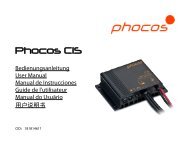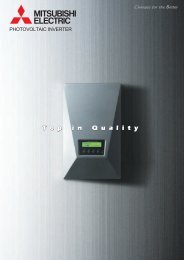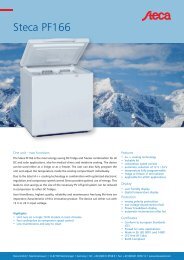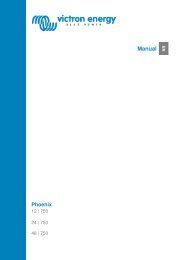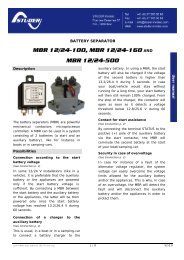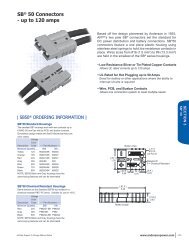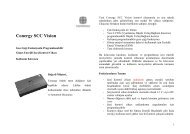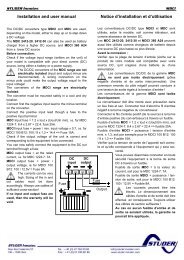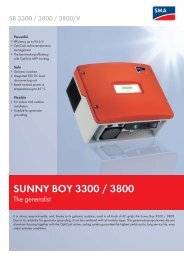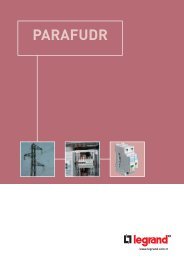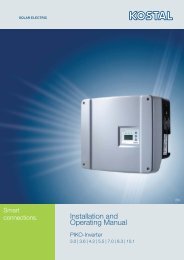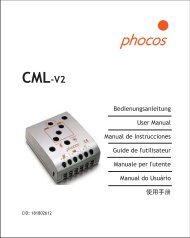Technical Manual - ODYSSEY Batteries
Technical Manual - ODYSSEY Batteries
Technical Manual - ODYSSEY Batteries
- No tags were found...
You also want an ePaper? Increase the reach of your titles
YUMPU automatically turns print PDFs into web optimized ePapers that Google loves.
Extreme cold temperature performanceHigh discharge rate performance in extremely coldconditions is another area in which <strong>ODYSSEY</strong> ® batteriesexcel. An example of this is shown in Figure 5. Even at-40°C (-40°F) the battery was able to support a 550A loadfor over 30 seconds before its terminal voltage dropped to7.2V.Figure 5: CCA test @ -40°C (-40°F) on 31-PC2150Voltage14.013.012.011.010.09.08.07.06.0Voltage profile at 550A discharge7.2VSince all <strong>ODYSSEY</strong> batteries are designed similarly, one canexpect similar outstanding cold temperature performancefrom any of the other <strong>ODYSSEY</strong> batteries.Parasitic loads30 seconds (test requirement)0 5 10 15 20 25 30 35 40Run time in seconds34.1 Secs.With the proliferation of more and more electronicequipment in cars, trucks, motorcycles and powersportsequipment, the phenomenon of parasitic loads is becominga serious problem.Parasitic loads are small currents, typically of the orderof a few milliamps (mA) that the battery has to delivercontinuously. Retaining memories and operating securitysystems are common examples of parasitic drains onbatteries in modern systems.On the surface it would seem that such small loads wouldnot be a factor in the overall scheme of things. However,since parasitic loads can be applied on a long-term basis(weeks or months is not uncommon), the cumulative amphours(Ah) extracted from the battery can be significant.For example, a 10mA draw on a motorcycle battery willdischarge it by 0.24Ah per day. If left unchecked for 30days, that small 10mA parasitic load will discharge a 20Ahbattery by 7.2Ah – a 36% depth of discharge (DOD).For reliable engine cranking, an <strong>ODYSSEY</strong> battery needsto have at least 70% of its capacity available. In otherwords, no more than 30% of the battery’s capacity can bedischarged for good starting performance. Thus batterycapacity and magnitude of the parasitic drain are neededto estimate the maximum number of days the load canbe tolerated before the battery’s cranking performance ispotentially compromised.To see how this works, consider the <strong>ODYSSEY</strong> 31-PC2150battery, which is a 92Ah BCI Group 31 size battery. Basedon the percent discharge criteria given in the previousparagraph, to ensure reliable engine cranking no more than28 amp-hours (30% of 92Ah) should be lost due to parasiticdrain. If the vehicle has a 100mA or 0.1A draw, then themaximum number of hours the battery should be allowed todischarge is 280 hours (28/0.10) or about 12 days.The following steps summarize how to estimate themaximum time your <strong>ODYSSEY</strong> battery can support aparasitic draw before its engine starting capability iscompromised.1. Determine the parasitic draw in amps; if you have thatnumber in milliamps, divide it by 1000 to convert it toamps and denote this as A par.2. Look up battery specification table to see your battery’samp-hour capacity at the 10-hour rate of discharge(C10) and multiply that by 0.30. This gives the maximumcapacity you can take out of the battery to support theparasitic drain and call this P cap to denote parasitic draincapacity in amp-hours.3. Divide P cap by A par (P cap/A par) to get the maximum hoursthe battery should be drained by the parasitic draw, thendivide that number by 24 to get the maximum number ofdays the battery should be allowed to discharge and stillbe able to reliably start.Regardless of the application, it is important to make sureyour battery does not have a parasitic load; if there is a slowdrain, connect the battery to a float (trickle) charger thatputs out between 13.5V and 13.8V at the battery terminals.Physically disconnecting one of the battery cables is analternate method to eliminate the drain.Shock, impact and vibrationtesting(A) Caterpillar 100-hour vibration testIn this test, a fully charged battery was vibrated at 34±1Hz and 1.9 mm (0.075") total amplitude in a verticaldirection, corresponding to an acceleration of 4.4g. Thetest was conducted for a total of 100 hours. The battery isconsidered to have passed the test if (a) it does not lose anyelectrolyte, (b) it is able to support a load test and (c) it doesnot leak when subjected to a pressure test.The <strong>ODYSSEY</strong> battery successfully completed this arduoustest.(B) Shock and vibration test per IEC 61373, Sections 8-10An independent test laboratory tested an <strong>ODYSSEY</strong> PC2150battery for compliance to IEC standard 61373, Category 1,Class B, and Sections 8 through 10. Section 8 calls for afunctional random vibration test, Section 9 requires a longliferandom vibration test and Section 10 is for a shock test.Table 2, on the next page summarizes the test results.14 www.odysseybattery.comPublication No: US-ODY-TM-001 - April 2011



